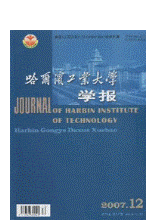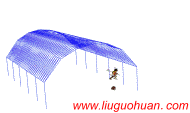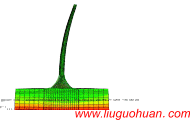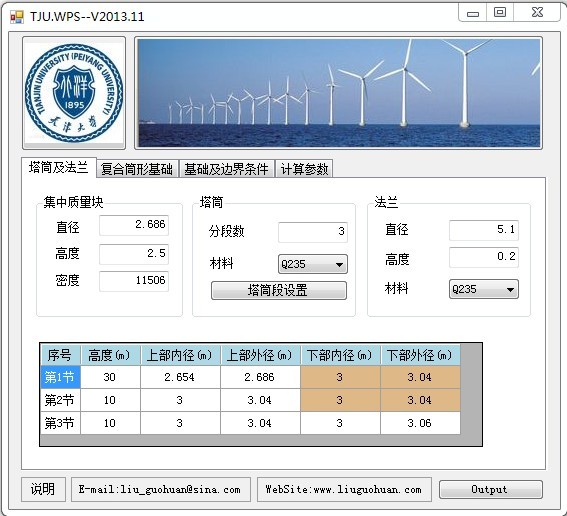非线性建筑物上的附属结构响应分析作者: 国巍, 李宏男, 柳国环 |
||||||
下载次数:
次 更多论文下载...
PDF格式(左键浏览,右键另存):
2010 年6 月
摘要:根据抗震规范设计的要求,在强烈地震作用下建筑结构会进入屈服阶段,对二次结构体系进行动力分析时需要考虑主体建筑结构的非线性。基于此,本文利用随机振动和等效线性化方法推导了由非线性主体结构和支撑于其上的附属结构所组成的二次结构体系的随机响应表达式,以此来分析了主体结构非线性对附属结构动力响应的影响,进而以附属结构的均方响应为研究指标,分析了主体结构非线性对附属结构最优位置的影响,并对多个附属结构的相互影响进行了研究,得到了一些有益的结论。 关键词:主体结构;非线性;等效线性化;附属结构;最优位置 中图分类号:TU318 文献标识码:A 文章编号:1007-4708(2010)03-0476-06 Abstract:Based on the code for seismic design of building in China, primary systems usually yield before secondary systems.destruction under the severe earthquake loading in practice, so the non-linearization characteristic of primary systems usually plays an important role in the dynamic analysis for primary-sec-ondary systems. Owing to this reason, the dynamic response expressions of primary-secondary systems are studied and proposed in this paper, which are based on the theory of random vibration and the equiv- alent linearization method. Then, the response expressions are used for explain the effect of nonlinearity of primary system on the response of secondary systems, while the response variance is adopted as the a-nalysis index. In the numerical analysis, two simple and generic structures, which is 3-degree of freedom and 10 degree of freedom respectively, are used to study the response properties. Moreover, the optimal position of secondary systems represented by the minimum response variance, and the interaction between multiple secondary systems are also calculated and analyzed. In the end, some valuable conclu-sions are studied. Key words:primary system; non-linearization; equivalent linearization; secondary system; optimal position 引言 二次结构体系是由主体结构和附属结构两部分组成的。一般将仪器设备、管线管道以及填充墙和天花板等称作附属结构,而把直接与地面相连的建筑结构称作主体结构。在地震作用下,尽管建筑物主体结构并没有损坏,但附属结构的损坏往往也会导致严重的后果,如核电站、电厂、医院以及于其他生命线工程等,其在地震作用下的完整性和持续运行性,对灾中和灾后的生命安全和生产恢复有着重要意义。从上世纪70年代开始,附属结构的安全性问题开始引起了人们的广泛关注和研究[1-10],然而早期的研究大多基于主体结构为线弹性的假设。由于强地震作用下主体结构往往进入屈服段,考虑主体结构的非线性特性更符合实际工程情况,可以得到更加合理的分析结果。因此,由非线性主体结构与附属结构构成的非线性二次结构体系有着重要的研究价值和现实意义。国外学者上对考虑非线性特性的二次结构体系进行了多方面的研究,主要包括非线性二次结构体系的动力特性[11-15],近似的计算方法[16,17],非线性对楼层反应谱的影响[18,19]等,而国内对二次结构体系非线性特性方面的研究则很少。 本文以高斯白噪声随机激励作为输入,同时考虑主体结构的非线性特征,以等效线性化的方法对支撑于非线性主体结构上的附属结构进行研究,指出了附属结构响应的影响因素,并与线性主体结构的情况进行比较,分析了非线性特性对附属结构响应和最优位置(附属结构均方响应最小处)的影响,同时本文还对多个附属结构之间相互作用的影响进行了分析。 结论 本文采用Y.K.Wen提出的非线性模型,以等效线性化的方法对非线性主体结构上单个和多个附属结构的动力响应进行了计算,研究了主体结构非线性对附属结构的影响,分析了附属结构动力响应的影响因素,并对多个附属结构之间的相互影响进行了分析,进而得到了一些有意义的结论。 (1)对小质量附属结构而言,在低频和高频段主体结构非线性对其影响较小;在中间频率段,特别是在主体结构低阶频率处非线性对附属结构的响应有着明显影响;随着附属结构质量的增加,附属结构与主体结构之间的相互作用增大,非线性对低频段大质量附属结构的影响仍然较小,在高频段的影响相对明显。同时,主体结构非线性对不同楼层位置处附属结构响应的影响也不相同,在主体结构中间频率范围内中间层附属结构受非线性的影响较大,这是由与附属结构相调谐频率对应的振型决定的。 (2)在线性主体结构上,附属结构的最优位置在低频段位于底层,在中间频率段位于主体结构的中间层,在高频段则比较复杂。在非线性主体结构上,当附属结构质量较小时,与线性主体结构类似,随着附属结构质量的增加,附属结构的最优位置也会发生较大的变化。但是与线性主体结构不同的是,此时在某些中低频率段附属结构的最优位置仍然可能位于主体结构的中间层甚至高层。 (3)主体结构上存在两个附属结构时,当附属结构2与主体结构的振动频率相调谐时,附属结构1的响应也会随着减小;当附属结构2频率与附属结构1的对应频率附近时,小范围的频率摄动可能会导致附属结构1响应的急剧起伏;当附属结构1和2的频率都处于主体结构的振动频率附近时,附属结构1的响应相应减小。 (4)不同楼层位置处的附属结构2对附属结构1有不同影响;主体结构的非线性减小附属结构2对附属结构1的影响,影响规律不变。 (5)随着附属结构2质量的增大,其对附属结构1的影响随着增大,而影响随着频率变化的大致规律并没有改变,附属结构2的存在对附属结构1的最优位置的影响较小。 参考文献(References): [1] Soong T T, Chen Y K. Seismic response of seconda-ry systems[J].Engineering Structures,1988,10:218-228. [2] 闵书亮,孙 峰,满振勇.附属结构地震反应的隔震方法[J].哈尔滨建筑工程学院学报,1993,26(4):19-26.(MIN Shu-liang, SUN Feng, MAN Zhen-yong.An isolation method for the earthquake responses of secondary structures[J].Journal of Harbin Archi-tecture and Civil Engineering Institute,1993,26(4):19-26.(in Chinese)) [3] 朱海华.基于性能的隔震结构非结构构件抗震性能研究[D].北京:北京工业大学,2006.(ZHU Ha-i hua.Performance-Based Seismic Design of Nonstructural Elements on Base Isolated Building[D].Beijing:Be-ijing University of Technology,2006.(in Chinese)) [4] 王歆玫,刘 季.在双向水平地震作用下建筑楼层反应谱法[J].哈尔滨建筑工程学院学报,1992,25(2):24-34.(WANG Xin-mei, LIU Ji. A floor response spectrum method of building subjected to bidirection horizontal earthquake excitation[J].Journal of Har-bin Architecture and Civil Engineering Institute,1992,25(2):24-34.(in Chinese)) [5] 秦 权,聂 宇.非结构构件和设备的抗震设计和简化计算方法[J].建筑结构学报,2001,22(3):15-20.(QIN Quan, NIE Yu.Seismic design and simplified analytical method of nonstructural components and e-quipment in buildings [ J].Journal of Building Structures,2001,22(3):15-20.(in Chinese)) [6] 张建霖,杨智春.随机输入条件下的楼层反应谱分析[J].西北工业大学学报, 2003,21(6): 650-653.(ZHANG Jian-lin, YANG Zh-i chun.A better analy-sis of floor response spectrum under random input for seismic design[J].Journal of Northwestern Poly-technical Universtiy,2003,21(6):650-653.(in Ch-inese)) [7] 汪嘉春,傅激扬,才来中.试验堆主厂房楼板谱计算与比较[J].核动力工程,2001,22(4):308-312.(WANG Jia-chun, FU J-i yang, CAI La-i zhong.Analysis and comparing the dynamic response of test reactor main workshop[J].Nuclear Power Engineering,2001,22(4):308-312.(in Chinese)) [8] 李忠献,陈 岩,梁万顺,等.核电厂结构的楼层反应谱分析[J].福州大学学报, 2005,33: 62-67. (LI Zhong-xian, CHEN Yan, LIANG Wan-shun, et al.Floor response spectrum under random input for seis-mic design[J].Journal of Northwestern Ploytechni-cal University,2005,33:62-67.(in Chinese)) 480计算力学学报 第27卷 [9] 李忠献,李忠诚,沈望霞.核反应堆厂房结构楼层反应谱的敏感性分析[J].核动力工程,2005,26(1):44-50.(LI Zhong-xian, LI Zhong-cheng, SHEN Wang- xia.Sensitivity analysis for floor response spectra of nuclear reactor buildings[J].Nuclear Power Engi-neering,2005,26(1):44-50.(in Chinese)) [10]荣 峰,汪嘉春,何树延,等.CARR堆反应堆厂房土壤-结构相互作用与楼层反应谱分析[J].核动力工程,2006,27(5):19-23.(RONG Feng, WANG Jia-chun, HE Shu-yan, et al.Analysis of Soi-l structure interaction and floor response spectrum of reactor building for China advanced research reactor[J].Nu-clear Power Engineering, 2006,27(5): 19-23. (in Chinese)) [11] Lin J, Mahin S A. Seismic response of light subsys-tems on inelastic structures[J].Journal of Structur-al Engineering,1985,111:400-417. [12] Igusa T.Response characteristics of inelastic 2-DOF primary-secondary systems[J].Journal of Engineer-ing Mechanics,1990,116,1160-1174. [13] Zhu W Q,Huang C D,Soong T T.Response and rel-iability of secondary systems in yielding structures [J].Probabilistic Engineering Mechanics, 1994,9:145-155. [14] Zhu W Q,Huang C D,Soong T T. Nonlinear Sto-chastic Response and Reliability of Secondary Sys-tems[J].Journal of Engineering Mechanics,1994,120(1):177-196. [15] Adam C,Fotiu P A.Dynamic analysis of inelastic pr-imary-secondary systems[J].Engineering Structures,2000,22:58-71. [16] Villaverde R. Simplified approach to account for non-linear effects in seismic analysis of nonstructural com-ponents[J].Seminar on Seismic Design, Retrofit and Performance of Non-Structural Components 1998,ATC-29-1:187-200. [17] Villaverde R. Simple method to estimate the seismic nonlinear response of nonstructural components in buildings [ J].Engineering Structures, 2006,28:1209-1221. [18] Singh M P, Chang R S, Suarez L E.Floor response spectrum amplification due to yielding of supporting structure[A].Proceedings of the 11th World Confer-ence on Earthquake Engineering[C].Acapulco,1996,Paper no.1444. [19] Ioannis P, Feau C. Some aspects of floor spectra of 1DOF nonlinear primary structures[J].Earthquake Engineering and Structural Dynamics, 2007,36:975-993. [20] Wen Y K. Method for random vibration of hysteretic systems [ J].Journal of Engineering Mechanics,1976,12:249-263. [21]李鸿光,何 旭,孟 光.Bouc-Wen滞回系统动力学特性的仿真研究[J].系统仿真学报,2004,16(9):2009-2011.(LI Hong-guang, HE Xu, Meng-guang. Numerical simulation for dynamic characteristics of B ouc-wen hysteretic system[J].Journal of System Simulation,2004,16(9):2009-2011.(in Chinese)) |
||||||
| welcome to www.liuguohuan.net |
| 天津大学 建筑工程学院 ; 天津大学 前沿技术研究院; 国家重点实验室-水利工程仿真与安全 |







